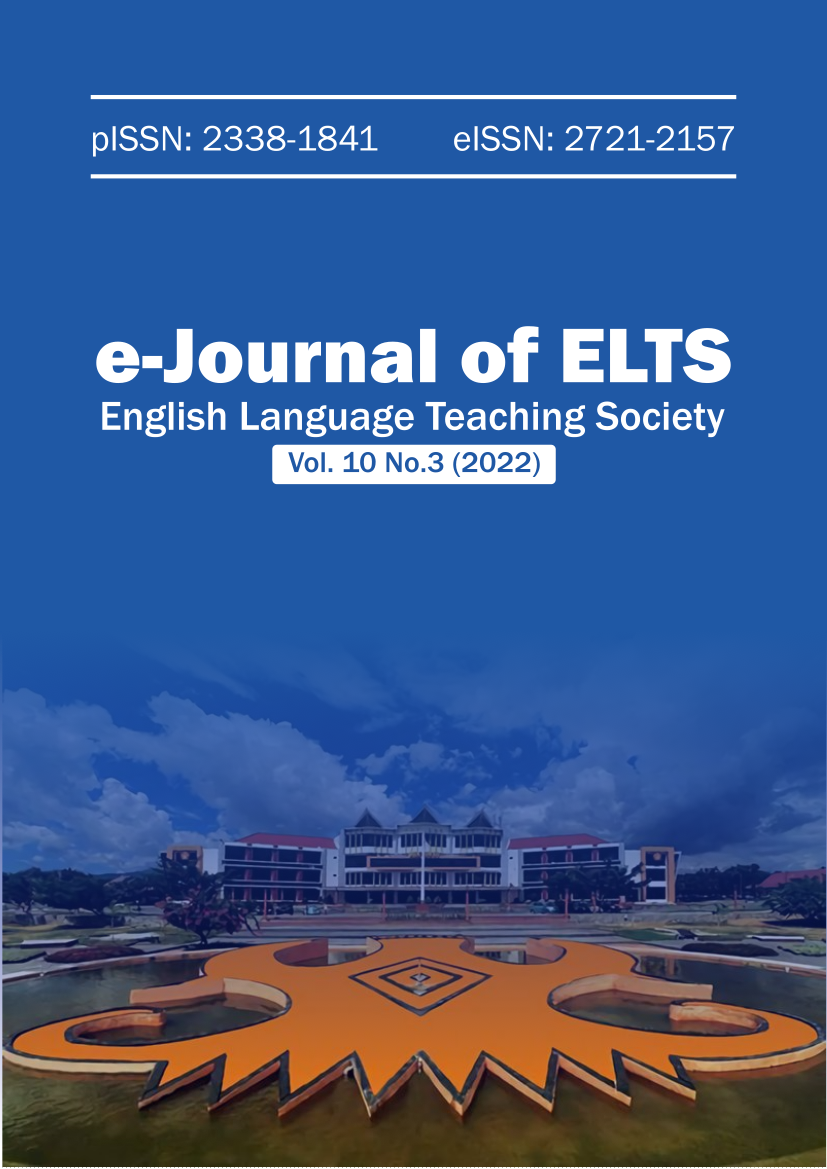USING HOMOPHONE GAMES TO IMPROVE PRONUNCIATION FOR HIGH SCHOOL STUDENT
DOI:
https://doi.org/10.22487/elts.v10i3.3182Keywords:
improve, Pronunciation, Homophone GamesAbstract
The objective of this research is to prove that the use of homophone games can improve pronunciation of the eleventh grade students at SMKN 1 Sojol. This research applied pre-experimental research design. The sample of this research was 21 eleventh grade students of ATPH 1 (Agribisnis Tanaman Pangan dan Horticultura) as known as Agriculture major, consisting of 21 students. The sample was selected by using a purposive sampling technique. The data were collected by administering a pronunciation test conducted before and after treatment, called pre-test and post-test. The result of pre-test and post-test shows that the mean score of pre-test is 34.44, and the mean score of post-test is 76.19. The result of data is analyzed statically by applying t-test formula. The result of data analysis shows that the value of the t-counted is(4.30) was higher than the t-table value (1.725) by applying 0.05 level of significance and 20 degree of freedom (df) 21-1 =20. The implication of this finding is to the betterment of teaching pronunciation is that the teacher needs to use Homophone Games to improve students’ pronunciation.
References
Arikunto, S. (2006). Prosedur Penelitian Suatu Pendekatan Praktek, Jakarta: PT. Rineka Cipta
Arikunto,S. (2006). Metode Penelitian Kuantitatif. Jakarta: Bumi Aksara
Astri, A, & Adha, R. (2020). Students’ ability in understanding Homophone in English . Journal of Linguistics, Literature & Language Teaching. 6(1): 31-54
Basri, H. (2005). English Phonology 1.Unpublished Handout
Cheng, F. (1998). The Teaching of Pronunciation to Chinese Studens of English. English Teaching Forum. 36(1): 37-39
Collins, B. (1972) English pronunciation problems of francophonic west Africans. ELT Journal. 27 (1): 79-88
Elliot, A. R. (1995). Foreign language phonology. The Modern Language Journal. 79(4): 530-542
Gotlieb, M. (2006). Assessing English Language Learners: Bridges from Language Proficiency to Academic Achievements Corwin Press. Thousand Oaks. CA
Hamelia (2021). The Influence of Homophone Games Towards Students’ Diphthong Pronunciation Mastery at the Second Semester of the Eleventh Grade of SMAN 1 Kota Agung. Kota Agung. Thesis. State Islamic University of Raden Intan Lampung
Hornby, A. S. (2005). Oxford Advanced Learner’s Dictionary. Oxford: Oxford University Press.
Kiswindari, C. (2018). Improving the students’ pronunciation through homophone game at the second grade students of SMA Asuhan Daya Medan. Medan. Thesis. State Islamic University of North Sumatera Medan.
Lin, H. F. C. & Chen. C. (1995). Teaching Pronunciation in the Learner-Centered Classroom. (ERIC Document Reproduction Service No. ED393292)
Morley, J. (1998). Trippingly on the Tongue: Putting Serious Speech/Pronunciation Instruction back in the TESOL. ESL Magazine. 1(15): 20-23
Muhammad, E. I. H. (2014). Pronunciation problems : a case study of English language student at Sudan University of science and technology. English Language and Literature Studies. 4(4): 31-44
Namazian, E. D. (2017). Pronunciation problems of high school EFL students: an error analysis approach with pedagogical implication. International Journal of English Research. 3(4): 77-82
Noll, M. & Collins, E. C. (2002). Strategies for Teaching Pronunciation and Error Correction.WATESOL: Professional Development Workshop.
Novitaningtyas, D. (2018). Homophone game as a medium to improve students’ pronunciation skill. Semarang. Thesis. State Semarang University
Pennington, M. C. & Richards, J. C. (1986). Pronunciation Revisited. TESOL Quarterly. 20(2): 32-49. From: http://dx.doi.org./10 2307/3586541
Pourhosein, A. G. & Banou, N. S. (2016). How can EFL teachers help EFL learners improve their English pronunciation. Journal of language teaching and research. 7(5): 967-972
Purhosein, A. G. (2012). The significance of pronunciation in English language teaching. Journal of English Language Teaching. 5(4): 96-107
Pratiwi, A. (2019). The use of homophone game to improve students’ pronunciation at the seventh grade of MTs NEGERI 2 SIDENRENG RAPPANG. Parepare. Thesis. State Islamic Institute (IAIN)
Quiz, F.(2020). Lilquizwhiz Fun English quiz [Homophones] [Video]. Youtube. https://youtu.be/AwRbfyJKrYk
Reskiawan, I. (2014). Homophone Game. Accessed on 15 September 2021 from http://imam11eleven.blogspot.co.id/2014/05/homphone-games.html
Ritonga, W. (2018). Improving students’ homophone through guessing game at grade XI SMA N 7 PADANGSIDIMPUAN. Padangsidimpuan. Thesis. State Islamic Institute Studies.
Scarla, R, & Oxford, R. L. (1994).Second Language Pronunciation : State of the Art in Instruction. System. 22(2): 221-230
Shanon, B. (1974). The Two Meanings of a Homophone. Perception & Psychophysics. 16(3): 571-574
Syamsiah, & Salamat, M. (2019) Using homophone game to improve students’ pronunciation at junior high school 5 Tidore Archipelago. Langua-journal of linguistics, literature, and language education. 2(1): 9-14
Yates, L. & Zielinski, B. (2009). Teaching Pronunciation to Adults. AMEP Research Centre. Department of Imigration and Citizenship. Mackuarie University. Sidney. Australia
Downloads
Published
How to Cite
Issue
Section
License
Copyright (c) 2023 Harsin Harsin, Rifiqoh Rifiqoh, Mashuri Mashuri

This work is licensed under a Creative Commons Attribution-ShareAlike 4.0 International License.
Authors who publish with e-Journal English Language Teaching Society (ELTS) agree to the following terms:
- Authors retain copyright and grant the journal right of first publication with the work simultaneously licensed under a Creative Commons Attribution License (CC BY-SA 4.0) that allows others to share the work with an acknowledgment of the work's authorship and initial publication in this journal.
- Authors are able to enter into separate, additional contractual arrangements for the non-exclusive distribution of the journal's published version of the work (e.g., post it to an institutional repository or publish it in a book), with an acknowledgment of its initial publication in this journal.
- Authors are permitted and encouraged to post their work online (e.g., in institutional repositories or on their website) prior to and during the submission process, as it can lead to productive exchanges, as well as earlier and greater citation of published work.








